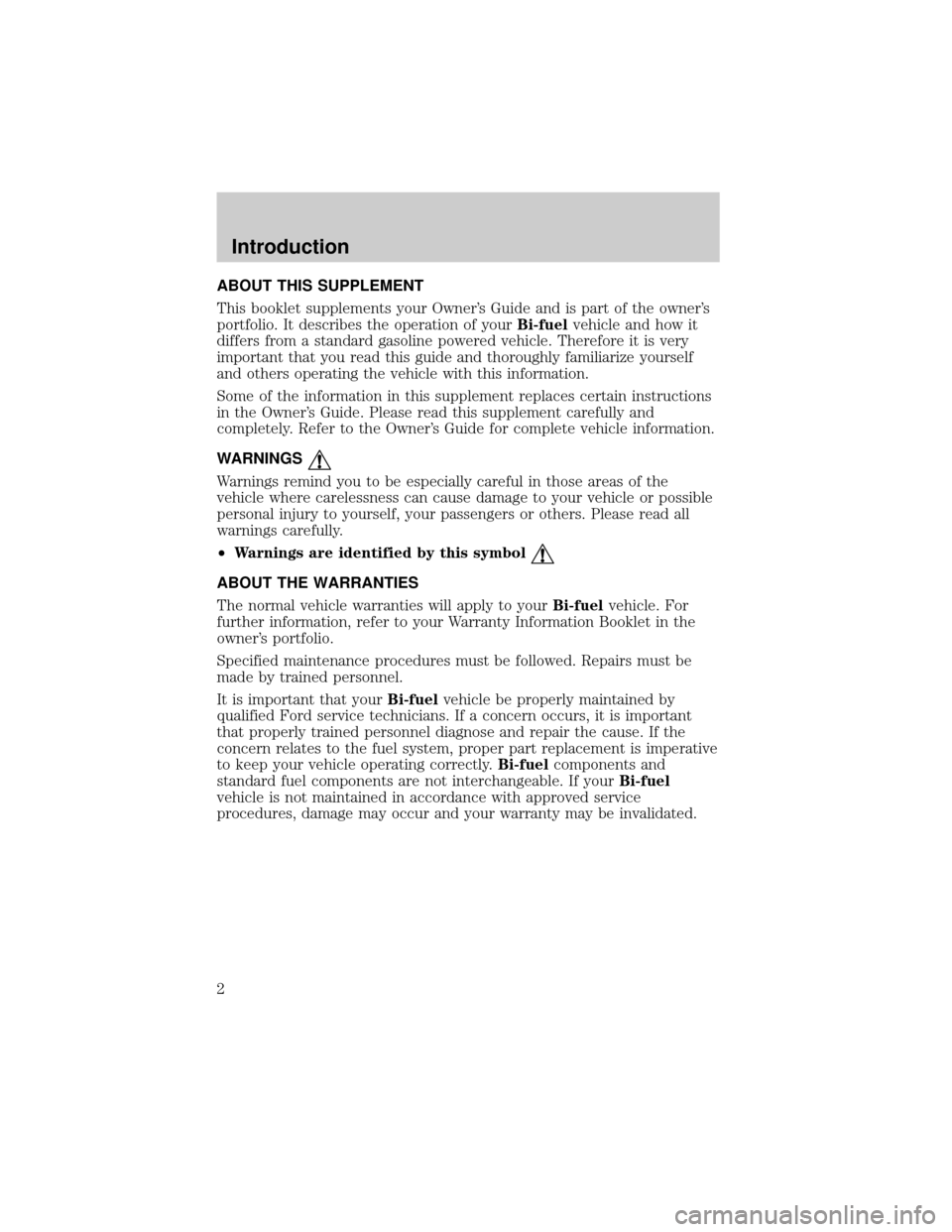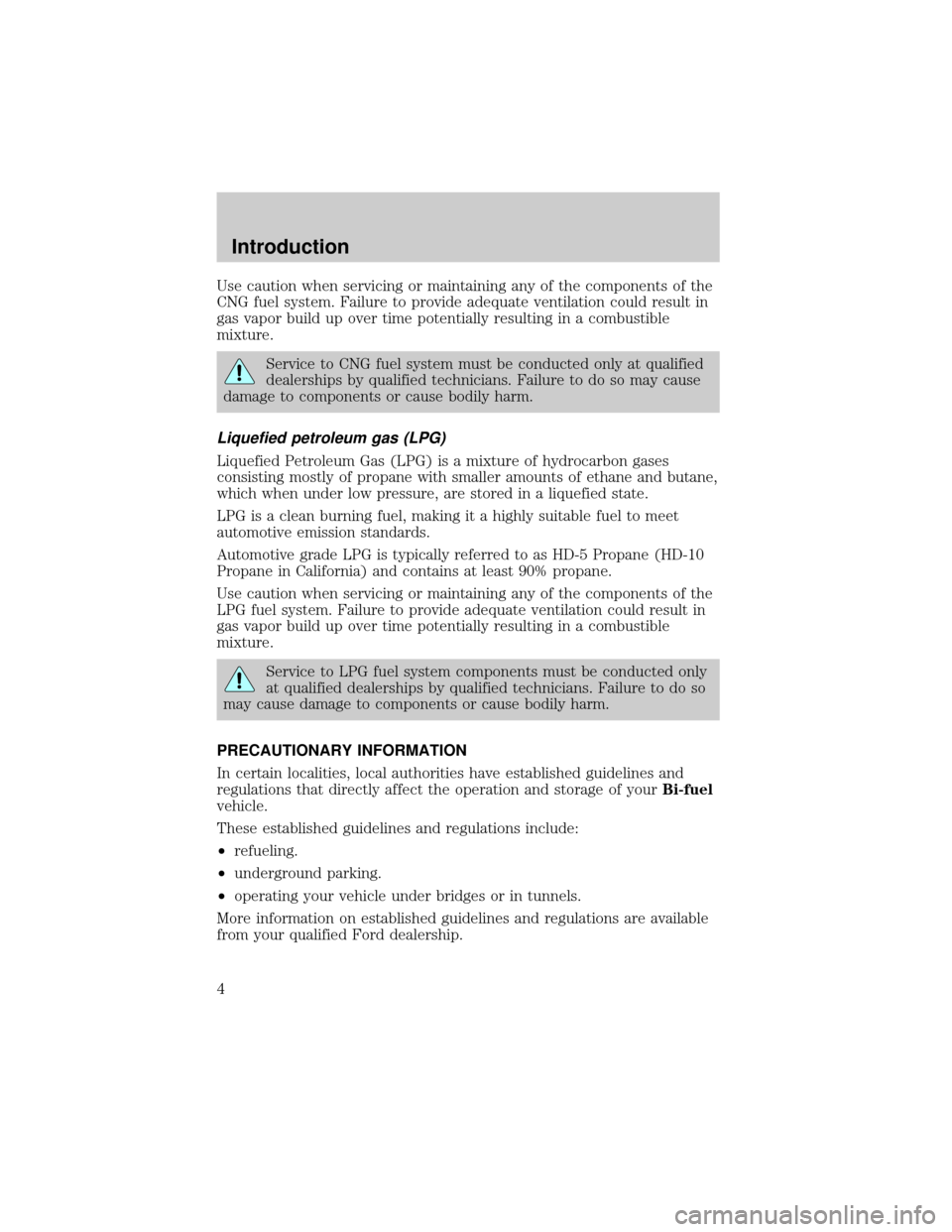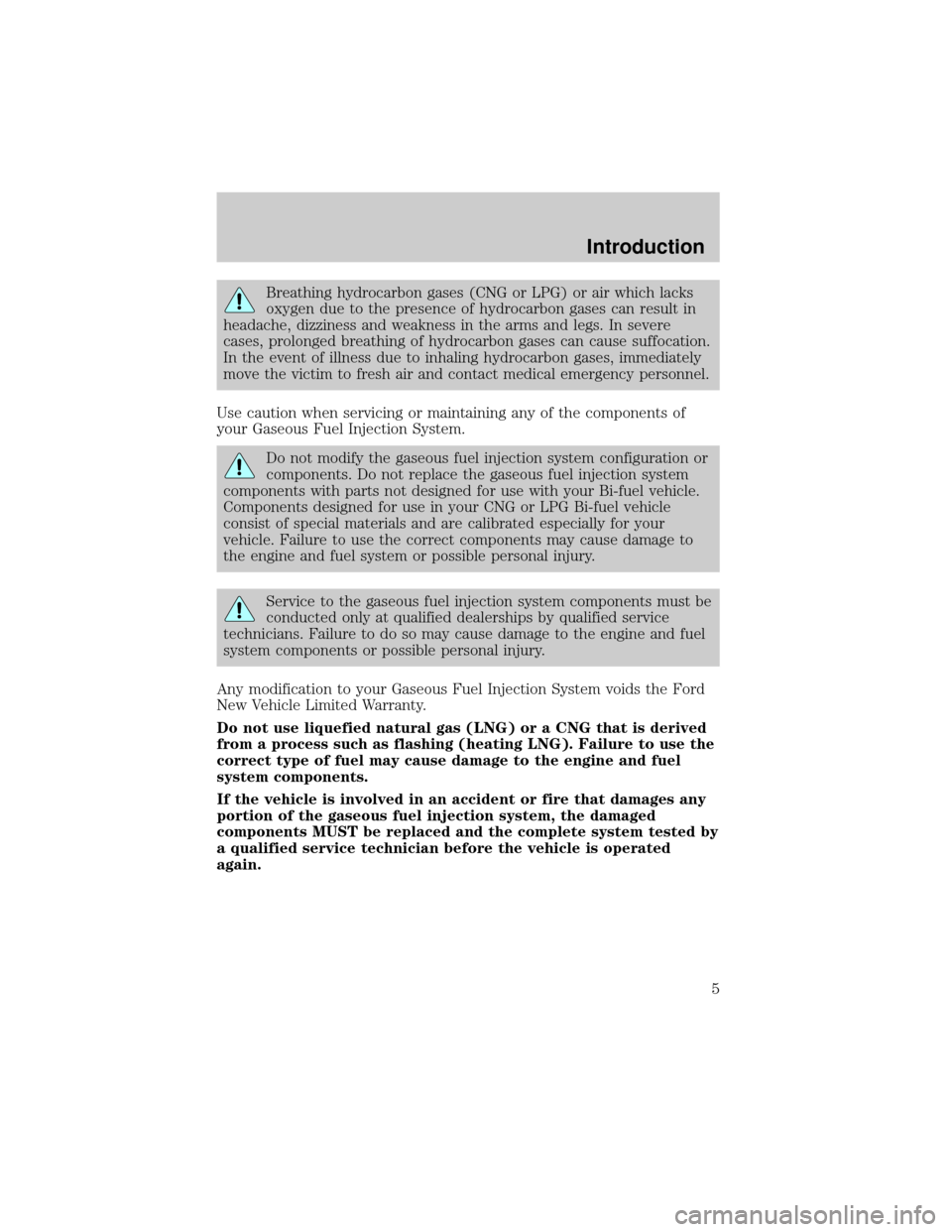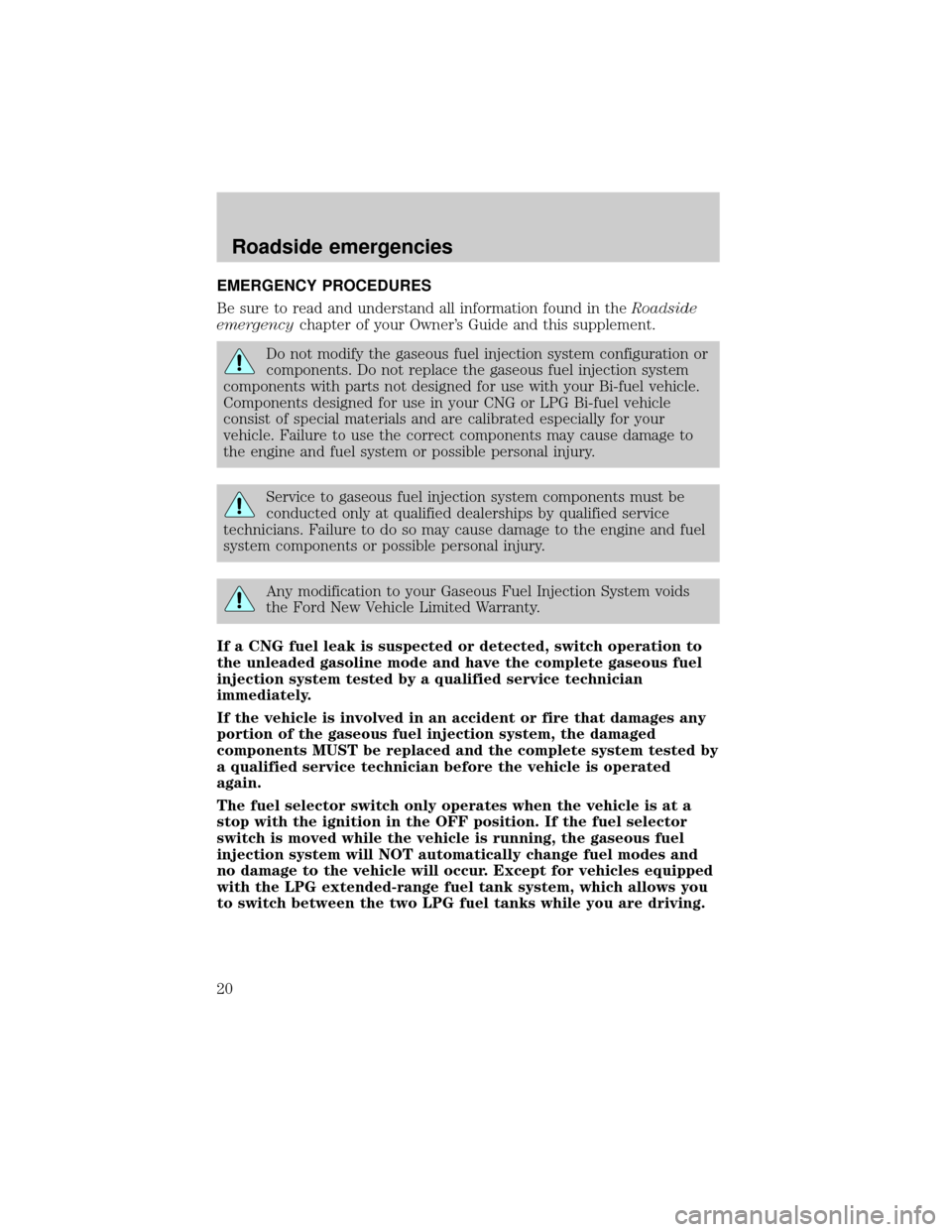2002 FORD F150 service
[x] Cancel search: servicePage 2 of 32

ABOUT THIS SUPPLEMENT
This booklet supplements your Owner's Guide and is part of the owner's
portfolio. It describes the operation of yourBi-fuelvehicle and how it
differs from a standard gasoline powered vehicle. Therefore it is very
important that you read this guide and thoroughly familiarize yourself
and others operating the vehicle with this information.
Some of the information in this supplement replaces certain instructions
in the Owner's Guide. Please read this supplement carefully and
completely. Refer to the Owner's Guide for complete vehicle information.
WARNINGS
Warnings remind you to be especially careful in those areas of the
vehicle where carelessness can cause damage to your vehicle or possible
personal injury to yourself, your passengers or others. Please read all
warnings carefully.
²Warnings are identified by this symbol
ABOUT THE WARRANTIES
The normal vehicle warranties will apply to yourBi-fuelvehicle. For
further information, refer to your Warranty Information Booklet in the
owner's portfolio.
Specified maintenance procedures must be followed. Repairs must be
made by trained personnel.
It is important that yourBi-fuelvehicle be properly maintained by
qualified Ford service technicians. If a concern occurs, it is important
that properly trained personnel diagnose and repair the cause. If the
concern relates to the fuel system, proper part replacement is imperative
to keep your vehicle operating correctly.Bi-fuelcomponents and
standard fuel components are not interchangeable. If yourBi-fuel
vehicle is not maintained in accordance with approved service
procedures, damage may occur and your warranty may be invalidated.
Introduction
2
Page 4 of 32

Use caution when servicing or maintaining any of the components of the
CNG fuel system. Failure to provide adequate ventilation could result in
gas vapor build up over time potentially resulting in a combustible
mixture.
Service to CNG fuel system must be conducted only at qualified
dealerships by qualified technicians. Failure to do so may cause
damage to components or cause bodily harm.
Liquefied petroleum gas (LPG)
Liquefied Petroleum Gas (LPG) is a mixture of hydrocarbon gases
consisting mostly of propane with smaller amounts of ethane and butane,
which when under low pressure, are stored in a liquefied state.
LPG is a clean burning fuel, making it a highly suitable fuel to meet
automotive emission standards.
Automotive grade LPG is typically referred to as HD-5 Propane (HD-10
Propane in California) and contains at least 90% propane.
Use caution when servicing or maintaining any of the components of the
LPG fuel system. Failure to provide adequate ventilation could result in
gas vapor build up over time potentially resulting in a combustible
mixture.
Service to LPG fuel system components must be conducted only
at qualified dealerships by qualified technicians. Failure to do so
may cause damage to components or cause bodily harm.
PRECAUTIONARY INFORMATION
In certain localities, local authorities have established guidelines and
regulations that directly affect the operation and storage of yourBi-fuel
vehicle.
These established guidelines and regulations include:
²refueling.
²underground parking.
²operating your vehicle under bridges or in tunnels.
More information on established guidelines and regulations are available
from your qualified Ford dealership.
Introduction
4
Page 5 of 32

Breathing hydrocarbon gases (CNG or LPG) or air which lacks
oxygen due to the presence of hydrocarbon gases can result in
headache, dizziness and weakness in the arms and legs. In severe
cases, prolonged breathing of hydrocarbon gases can cause suffocation.
In the event of illness due to inhaling hydrocarbon gases, immediately
move the victim to fresh air and contact medical emergency personnel.
Use caution when servicing or maintaining any of the components of
your Gaseous Fuel Injection System.
Do not modify the gaseous fuel injection system configuration or
components. Do not replace the gaseous fuel injection system
components with parts not designed for use with your Bi-fuel vehicle.
Components designed for use in your CNG or LPG Bi-fuel vehicle
consist of special materials and are calibrated especially for your
vehicle. Failure to use the correct components may cause damage to
the engine and fuel system or possible personal injury.
Service to the gaseous fuel injection system components must be
conducted only at qualified dealerships by qualified service
technicians. Failure to do so may cause damage to the engine and fuel
system components or possible personal injury.
Any modification to your Gaseous Fuel Injection System voids the Ford
New Vehicle Limited Warranty.
Do not use liquefied natural gas (LNG) or a CNG that is derived
from a process such as flashing (heating LNG). Failure to use the
correct type of fuel may cause damage to the engine and fuel
system components.
If the vehicle is involved in an accident or fire that damages any
portion of the gaseous fuel injection system, the damaged
components MUST be replaced and the complete system tested by
a qualified service technician before the vehicle is operated
again.
Introduction
5
Page 6 of 32

If yourBi-fuelvehicle is to be painted, the CNG or propane fuel tank(s)
and fuel lines must be emptied before the vehicle is placed in a heated
room, known as a ªpaint ovenº, for the new paint to cure. These ªpaint
ovensº typically operate at temperatures up to 60É C (140É F). The high
temperatures in the ªpaint ovenº could cause the fuel in the fuel tanks to
expand, which may cause an overpressure condition within the fuel tanks
that can be hazardous to personal safety and property. Contact your
qualified Ford dealership for assistance.
Do not use paint drying ovens for propane-fueled vehicles. The
heat of paint drying ovens will increase the pressure in the fuel
tanks. This could cause venting of propane fuel vapor into the oven
and result in a fire from the heat or sparks in the electrical equipment.
If the fuel is confined inside an oven, an explosion may occur. When
refinishing the body panels of a propane-fueled vehicle, use spot
painting and drying methods.
Failure to empty (vent) the CNG or propane fuel tank(s) and
fuel lines prior to vehicle being placed in a ªpaint ovenº may
cause an overpressure condition within the fuel tanks that can be
hazardous to personal safety and property.
On F-Series Bi-fuel vehicles, do notmodify or replace the cargo bed
with any non-OEM components. Should the cargo bed need to be
removed for service or replacement, it should be done at a qualified
dealership using qualified service technicians. Do not sit, stand or place
heavy loads on the in-bed fuel tank cover. Any cap added to the cargo
bed on this vehicle must be vented to the outside (consult your local
regulations). Failure to provide adequate ventilation could result in gas
vapor build up over time, potentially resulting in a combustible mixture.
Introduction
6
Page 15 of 32

WARNING LIGHTS
With the engine running, the ªCheck Engine/Service Engine Soonº
indicator light (depending upon application) will illuminate on the
instrument cluster when the On Board Diagnostics System and/or the
Gaseous Fuel Injection System detects a malfunction in one of the
engine's emission controls. For more information, refer toWarning light
and chimesin theInstrumentationchapter of your Owner's Guide and
this supplement.
If a malfunction of the Gaseous Fuel
Injection System is detected with
the engine running in the gaseous
fuel mode, the green indicator light
on the fuel selector switch will flash
on and off.
The warning lights may illuminate or flash on and off (depending upon
application) without a driveability concern being noted. The vehicle will
usually be drivable and will not require towing. Contact a qualified Ford
dealership at the first available opportunity.
GASALT
Instrumentation and controls
15
Page 20 of 32

EMERGENCY PROCEDURES
Be sure to read and understand all information found in theRoadside
emergencychapter of your Owner's Guide and this supplement.
Do not modify the gaseous fuel injection system configuration or
components. Do not replace the gaseous fuel injection system
components with parts not designed for use with your Bi-fuel vehicle.
Components designed for use in your CNG or LPG Bi-fuel vehicle
consist of special materials and are calibrated especially for your
vehicle. Failure to use the correct components may cause damage to
the engine and fuel system or possible personal injury.
Service to gaseous fuel injection system components must be
conducted only at qualified dealerships by qualified service
technicians. Failure to do so may cause damage to the engine and fuel
system components or possible personal injury.
Any modification to your Gaseous Fuel Injection System voids
the Ford New Vehicle Limited Warranty.
If a CNG fuel leak is suspected or detected, switch operation to
the unleaded gasoline mode and have the complete gaseous fuel
injection system tested by a qualified service technician
immediately.
If the vehicle is involved in an accident or fire that damages any
portion of the gaseous fuel injection system, the damaged
components MUST be replaced and the complete system tested by
a qualified service technician before the vehicle is operated
again.
The fuel selector switch only operates when the vehicle is at a
stop with the ignition in the OFF position. If the fuel selector
switch is moved while the vehicle is running, the gaseous fuel
injection system will NOT automatically change fuel modes and
no damage to the vehicle will occur. Except for vehicles equipped
with the LPG extended-range fuel tank system, which allows you
to switch between the two LPG fuel tanks while you are driving.
Roadside emergencies
20
Page 22 of 32

SERVICE RECOMMENDATIONS
Before you service yourBi-fuelvehicle, read and understand all
information found in theMaintenance and carechapter of your
Owner's Guide and this supplement.
Refer to your scheduled maintenance guide for service requirements and
intervals.
Do not modify the gaseous fuel injection system configuration or
components. Do not replace the gaseous fuel injection system
components with parts not designed for use with your Bi-fuel vehicle.
Components designed for use in your CNG or LPG Bi-fuel vehicle
consist of special materials and are calibrated especially for your
vehicle. Failure to use the correct components may cause damage to
the engine and fuel system or possible personal injury.
Service to gaseous fuel injection system components must be
conducted only at qualified dealerships by qualified service
technicians. Failure to do so may cause damage to the engine and fuel
system components or possible personal injury.
Any modification to your Gaseous Fuel Injection System voids
the Ford New Vehicle Limited Warranty.
GASEOUS FUEL INJECTION SYSTEM SHUTOFF
When in the gaseous fuel mode under normal operating procedures, the
flow of CNG or LPG (depending upon application) is stopped when the
ignition is turned to the OFF position. The electrically operated control
valve(s) only allow the flow of fuel when the ignition is in the ON
position, with the engine running.
Liquefied petroleum gas (LPG)
If equipped with the manually-actuated supply valve(s), the flow of LPG
to the engine can be stopped by closing the supply valve located on the
LPG fuel tank(s).
If equipped, the manually-actuated supply valve(s) must be in the full
OPEN position for the engine to run on LPG.
Maintenance and care
22
Page 25 of 32

Many localities have restrictions on refueling CNG and LPG fueled
vehicles. In these localities, only qualified technicians at designated
refueling stations are allowed to refuel your vehicle. Refer to your
local authorized Ford dealer for more information.
Fuel fill procedure Ð compressed natural gas (CNG)
Two methods for filling the CNG fuel tank(s) are available toCNG
Bi-fuelvehicle owners:
²The fast-fill method Ð available at many of the commercial and
privately owned CNG refueling stations.
²The slow-fill method Ð available for purchase or lease from a number
of commercial or natural gas utility companies.
ªFast-fillingº aCNG Bi-fuelvehicle involves rapidly raising the pressure
in the vehicle's tank(s) by a ªfast-fillº refueling station (typical fill time:
3±5 minutes). ªFast-fillingº aCNG Bi-fuelvehicle provides the greatest
convenience to the driver in terms of time spent refueling.
ªFast-fillº refueling technology does not presently allow aCNG Bi-fuel
vehicle to be completely refueled to its maximum rated capacity.
Therefore, ªfast-fillingº results in a reduced driving range and an initial
fuel gauge reading of Full. However, within approximately 10 minutes,
the fuel gauge of aCNG Bi-fuelvehicle that has been ªfast-filledº will
drop about 1/8th of a tank lower to reflect the reduced amount of fuel
that was actually added.
ªSlow-fillingº aCNG Bi-fuelvehicle involves slowly raising the pressure
in the vehicle's tank(s) by a ªslow-fillº refueling station (typical fill rate:
6±8 hours). ªSlow-fillingº aCNG Bi-fuelvehicle usually is done
overnight and allows the greatest amount of CNG fuel to be added to a
CNG Bi-fuelvehicle. A properly functioning ªslow-fillº refueling station
will fill the CNG fuel tank(s) to a fuel gauge reading of Full at a
temperature of 21ÉC (70ÉF).
The CNG fueling point, or fuel receptacle is located on the driver's side
of the vehicle.
The profiles of both the CNG fueling point and the fuel station nozzle are
specified by ANSI/AGA NGV1-1994, CGA NGV1-M94. These profiles are
specified for CNG vehicles and fuel stations for safety purposes. Three
separate adapter profiles are available. P24, P30 and P36 respectively,
are specified for the three different service pressures of 16 500 kPa
(2 400 psi), 20 700 kPa (3 000 psi) and 24 800 kPa (3 600 psi).
Maintenance and care
25